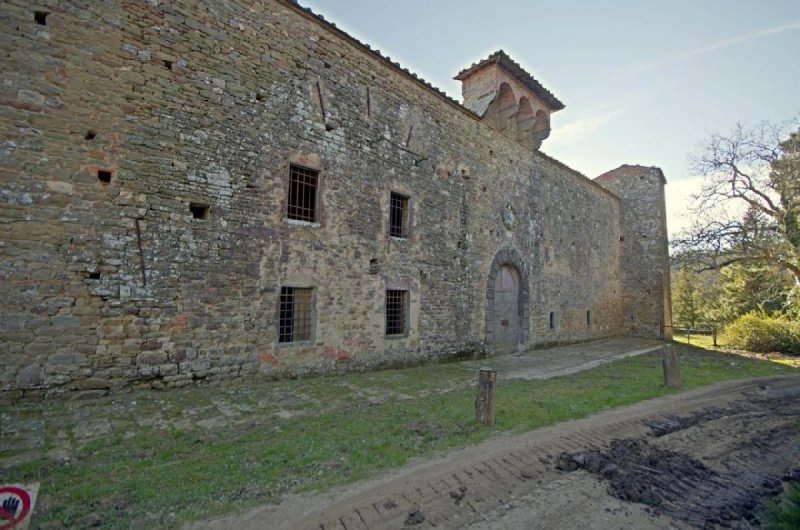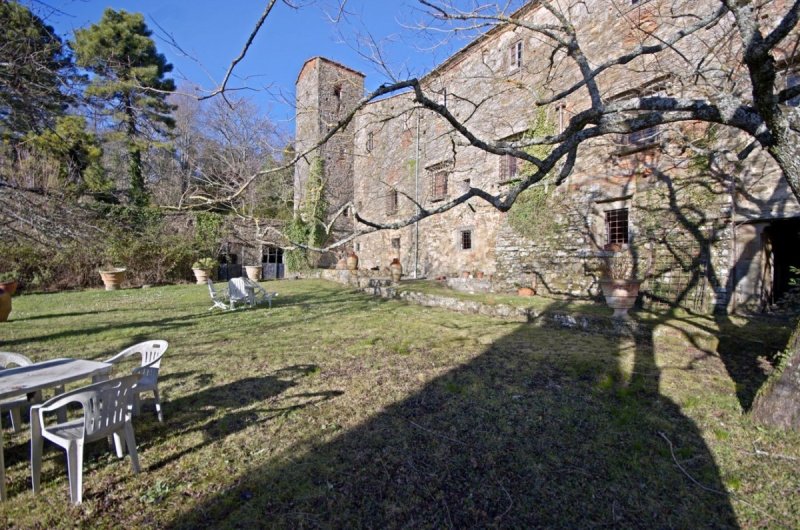BADIA The last treasure of the Chianti region. ABOUT THE ABBEY The origins of the Abbey of are lost in the Medieval nights. The historians agree on the fact that it was the fourth Abbey after Vallombrosa, founded by San Giovangualberto and they place its foundation around 1040. Emanuele Repetti (historian, 1776-1852) remembers it had been a 'monastery of secular monks' when in January of the year 1040, the noblemen of the nearby Castello di Cintoia offered the inhabitants of the convent various plots of neighbourhood land. It is most likely that after those donations St.Giovangualberto introduced the rule of the Vallombrosans. Prior Fedele Sodani, Vallombrosan and founder of the Abbey at Coltibuono, mentions the year 1038 as the foundation, but we have no idea on which documentation this statement is based. The Abbey, like other big monastic estates, has been subjugated by the Republic of Florence to a 'regime in commandam' a real disaster for the big and opulent abbeys. This regime was proclaimed by the same Florentine Republic on May 14, 1455. Various chiefs in command impoverished a part of its antique riches in favour of the Republic, but in the two following centuries the Abbey reclaimed its natural role of centre of power. The centrality of its power is also demonstrated by the numerous works that the Florentine Renaissance has produced on commission of the monks. Amongst these works, the bronze bell realised by Verrocchio, lost by now, a crucifixion attributed to Bernardo di Stefano Rosselli, that goes back to the end of the 1400's, numerous traces of frescos, hidden by layers of posthumous paint, probably dating back to the first half of the '400s, as well as the coat of arms attributed to Luca Della Robbia. The 16th and 17th centuries were rather troubled centuries for the entire Order of Vallombrosa and this consented the monks to renovate and enlarge the complex. The next 18th century, the last for the monastic community of Vallombrosa, was different. After the transfer of the last monks, the Abbey was put on auction in 1930 and bought by the noble family Rosselli Del Turco that retained ownership until the beginning of the 1990's. The premises and consistency The Abbey consists mainly of three levels (ground floor, first floor and basement)and is made of stone, cotto tiles and wood. There are two inner courts, one with a stone well on which you can see the coat of arms of the Abbey, and a loggia on two of its four sides. Worth mentioning are the huge stables in the basement, the big salon that leads to a splendid garden, the church that was bombed during WWII and partially rebuilt in 1945, Part of the complex are two farmhouses at some 100m distance of the Abbey. The total surface of the Abbey is ca. 5000m2 and 1200m2 for the farmhouses. The complex is situated in a large territory covered with forrests and surrounded by its own land of about a 100ha.
Idioma a partir do qual a tradução automática foi gerada
BADIA L'ultimo tesoro del Chianti. SULL'ABBAZIA Le origini dell'Abbazia si perdono nelle notti medievali Gli storici concordano sul fatto che fosse la quarta Abbazia dopo Vallombrosa, fondata da SanGiovangualberto e ne pongono la fondazione intorno al 1040. Emanuele Repetti (storico, 1776-1852) ricorda che era stato un "monastero di monaci secolari" quando nel gennaio del 1040 i nobili del vicino Castello di Cintoia offrirono a questi abitanti del convento vari appezzamenti di terreno situati nei suoi pressi. È molto probabile che dopo quelle donazioni San Giovangualberto vi introdusse il dominio dei Vallombrosani. Il priore Fedele Sodani, vallombrosano e fondatore dell'Abbazia di Coltibuono, cita l'anno 1038 per la fondazione, ma non abbiamo idea di quale documentazione si basi questa affermazione. L'Abbazia, come altri grandi possedimenti monastici, è stata soggiogata dalla Repubblica di Firenze ad un "regime in commandam" un vero disastro per le grandi e opulente abbazie. Questo regime fu proclamato dalla stessa Repubblica Fiorentina il 14 maggio 1455 ma, sebbene i suoi vari capi al comando impoverissero una parte delle sue antiche ricchezze a favore della Repubblica, nei due secoli successivi l'Abbazia rivendicò il suo naturale ruolo di centro di energia. La centralità del suo potere è dimostrata anche dalle numerose opere che il Rinascimento fiorentino ha prodotto su commissione dei monaci, tra tutte la campana in bronzo realizzata dal Verrocchio ormai perduta, una crocifissione attribuita a Bernardo di Stefano Rosselli che risale alla fine del Quattrocento, numerose tracce di affreschi nascoste da strati di pittura postuma, risalenti probabilmente alla prima metà del '400 interamente da valutare e studiare, così come lo stemma attribuito a Luca Della Robbia. I secoli XVI e XVII furono piuttosto travagliati per l'intero Ordine di Vallombrosa e tanta fortuna acconsentì ai monaci di ristrutturare e ampliare il complesso. Il Settecento successivo, l'ultimo per la comunità monastica di Vallombrosa, fu diverso. Dopo il trasferimento degli ultimi monaci l'Abbazia vu venduta nel 1930 e acquistata dalla nobile famiglia Rosselli Del Turco che ne mantenne la proprietà fino all'inizio degli anni '90. Le premesse e la coerenza L'Abbazia è costituita principalmente da tre livelli (piano terra, primo piano e seminterrato) ed è realizzata in pietra, cotto e legno. Vi sono due cortili interni, in uno dei quali si trova un pozzo in pietra su cui si può vedere lo stemma dell'Abbazia, e una loggia su due dei quattro lati di esso. Da segnalare le enormi scuderie al piano interrato, il grande salone che immette in uno splendido giardino, la chiesa bombardata durante la seconda guerra mondiale e parzialmente ricostruita nel 1945, Fanno parte del complesso due case coloniche a circa 100 metri dall'Abbazia. In totale la superficie lorda dell'Abbazia è di ca. 5000m2 e 1200m2 per le case coloniche. Il complesso è situato in un ampio territorio ricoperto da boschi e circondato da un terreno di proprietà per una proprietà di circa 100ha.
Der letzte Schatz der Chianti-Region. ÃÂÃÂBER DIE ABTEI Die UrsprÃÂünge der Abtei gehen in den mittelalterlichen NÃÂächten verloren. Die Historiker sind sich einig, dass es nach Vallombrosa die vierte Abtei war, die von San Giovangualberto gegrÃÂündet wurde, und sie grÃÂünden sie rund 1040. Emanuele Repetti (Historiker, 1776-1852) erinnert sich, dass es sich um ein ÃÂÃÂKloster weltlicher MÃÂönche" handelte, als die Adligen des nahe gelegenen Castello di Cintoia, diesen Bewohnern des Klosters im Januar 1040 verschiedene umliegende GrundstÃÂücke anboten. Es ist sehr wahrscheinlich, dass St.Giovangualberto nach diesen Spenden, dort die Herrschaft der Vallombrosaner einfÃÂührte. Der Abt Fedele Sodani, Vallombrosan und GrÃÂünder der Abtei von Coltibuono, erwÃÂähnt das Jahr 1038 fÃÂür die GrÃÂündung , aber wir haben keine Ahnung, auf welcher Dokumentation diese Aussage sich basiert. Die Abtei wurde, wie andere groÃÂÃÂe KlostergÃÂüter, von der Republik Florenz einem ÃÂÃÂRegime in Commandam" unterworfen, eine echte Katastrophe fÃÂür die groÃÂÃÂen und opulenten Abteien. Dieses Regime wurde am 14. Mai 1455 von derselben Florentiner Republik proklamiert und ihre verschiedenen Befehlshaber verarmten einen Teil ihres antiken Reichtums zugunsten der Republik. Die Abtei erlangte in den beiden folgenden Jahrhunderten aber ihre natÃÂürliche Rolle als Machtzentrum zurÃÂück. Die ZentralitÃÂät seiner Macht zeigt sich auch in den zahlreichen Werken, die die Florentiner Renaissance im Auftrag der MÃÂönche hervorgebracht hat; unter all der Bronzeglocke von Verrocchio, die inzwischen verloren gegangen ist, einer Kreuzigung, die Bernardo di Stefano Rosselli zugeschrieben wird und bis zum Ende von den 1400er Jahren zurÃÂückreicht, zahlreiche Spuren von Fresken, die durch Schichten posthumer Farbe verborgen sind, und wahrscheinlich auf die erste HÃÂälfte der 400er Jahre zurÃÂückgehen, sowie das Wappen, das Luca Della Robbia zugeschrieben wird. Das 16. und 17. Jahrhundert war fÃÂür den gesamten Orden von Vallombrosa ziemlich beunruhigt, und diese Situation stimmte den MÃÂönchen zu, den Komplex zu renovieren und zu vergrÃÂöÃÂÃÂern. Das nÃÂächste 18. Jahrhundert, das letzte fÃÂür die Klostergemeinschaft von Vallombrosa, war anders. Nach der ÃÂÃÂbergabe der letzten MÃÂönche wurde die Abtei 1930 versteigert und von der Adelsfamilie Rosselli Del Turco gekauft, die bis Anfang der 90er Jahre das Eigentum behielt. Die PrÃÂämissen und Konsistenz Die Abtei besteht hauptsÃÂächlich aus drei Ebenen (Erdgeschoss, erster Stock und Keller) und besteht aus Stein, Terracottasteine und Holz. Es gibt zwei InnenhÃÂöfe, in einem befindet sich ein Steinbrunnen, auf dem man das Wappen der Abtei sehen kann, und eine Loggia auf zwei der vier Seiten. ErwÃÂähnenswert sind die riesigen StÃÂälle im Keller, der groÃÂÃÂe Salon, der zu einem herrlichen Garten fÃÂührt, die Kirche, die wÃÂährend des Zweiten Weltkriegs bombardiert und in 1945 teilweise wiederaufgebaut wurde. Teil des Komplexes sind zwei BauernhÃÂäuser in etwa 100 m Entfernung von der Abtei. Insgesamt betrÃÂägt der Umfang der Abtei ca. 5000m2 und 1200m2 fÃÂür die BauernhÃÂäuser. Der Komplex befindet sich in einem groÃÂÃÂen, mit WÃÂäldern bedeckten Gebiet und ist von eigenem Land von ca. 100 ha umgeben.


